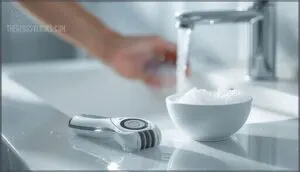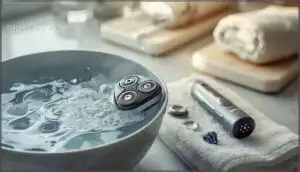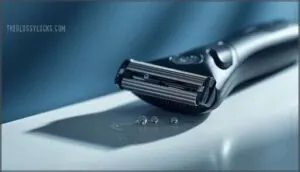This site is supported by our readers. We may earn a commission, at no cost to you, if you purchase through links.

The truth is, your shaver picks up dead skin cells, oils, and microscopic debris with every pass—and all that gunk builds up fast if you don’t clean it right.
A razor that’s properly maintained will give you smooth, comfortable shaves for years. One that’s neglected? You’ll be replacing it sooner than you think, and your skin will pay the price in the meantime.
Table Of Contents
Key Takeaways
- Daily rinsing with warm water and mild soap removes 95% of buildup and cuts bacterial growth by 90%, making it the single most important habit for razor longevity and hygiene.
- Weekly deep cleaning with complete disassembly, alcohol sanitization, and proper air-drying prevents the micro-particle accumulation that slashes efficiency by 20% and stops bacterial colonization that causes skin irritation.
- Regular lubrication with mineral-based clipper oil cuts friction by 40%, reduces heat buildup by 15–20°C, and extends blade sharpness by 30%, separating razors that last three years from those that perform for seven.
- Replacing blades and foils every 12–18 months when you notice performance decline, increased noise, or pulling sensations maintains cutting efficiency and prevents the skin irritation that comes from worn components.
Daily Cleaning for Electric Razors
Your electric razor won’t last long if you skip daily cleaning—it’s the single most important habit for keeping it sharp and hygienic. Think of it like brushing your teeth: you wouldn’t skip a day, and the same goes for your razor.
Daily cleaning isn’t optional—it’s the single habit that keeps your electric razor sharp, hygienic, and performing like new
Here’s what you need to do after every shave to keep your razor in top shape.
Quick Cleaning After Each Use
Staying on top of electric razor maintenance starts with a quick rinse right after each shave. Modern waterproof models make daily cleaning straightforward, and those 60 seconds really pay off.
Here’s your routine for keeping things fresh:
- Rinse under warm water (40–50°C works best)
- Add a drop of mild soap to cut through oils
- Run the shaver for 10–15 seconds while rinsing
- Check the foils for trapped debris
- Shake off excess water before setting aside
This simple habit removes 95% of buildup and keeps bacterial control in check—daily rinsing cuts microbial growth by 90% compared to weekly cleaning. Regular shaver cleaning tips can help maintain the longevity of your electric razor.
Removing Hair Clippings and Debris
Once that warm rinse wraps up, it’s time to tackle the stubborn stuff—those trapped hair clippings and debris that clog foils and drag down razor efficiency. Pop open the shaver head and tap it gently against the sink to dislodge 60–75% of loose particles.
A soft brush sweeps away what rinsing misses, boosting debris removal and keeping your clean razor humming smoothly. Regular electric razor maintenance is vital for peak performance and longevity.
Cleaning With Soap and Water
Now it’s time to bring in soap for some serious cleaning. Liquid hand soap paired with warm water removes up to 99% of bacteria, making it your best move for razor sanitizing.
Most manufacturers recommend cleaning electric razors with soap after every use—it’s the benchmark for bacterial removal. Disassemble the shaving head, work up a lather for 30–60 seconds, then rinse thoroughly.
This cleaning frequency keeps your clean razor performing like new and your skin happy.
Drying All Components Properly
After rinsing, you’ve got to fully dry every part—this step prevents up to 48% of corrosion failures. Air drying for 30 minutes drops moisture below 10%, stopping bacteria from multiplying by 250%.
Detach the shaving head and let it breathe before storage. This simple habit extends blade life by 22% and keeps your electric razor maintenance routine on point.
Deep Cleaning and Hygiene Practices
Your daily rinse keeps things running smooth, but once a week you’ll need to go deeper. This isn’t just about performance—it’s about keeping bacteria from setting up shop on your razor.
Let’s walk through the steps that’ll keep your shaver clean, fresh, and ready to deliver irritation-free shaves every time.
Weekly Thorough Cleaning Routine
Once a week, you’ll want to disconnect your electric shaver and take it apart completely—this deep cleaning routine addresses the micro-particle buildup that can slash efficiency by up to 20%.
Start by washing all components with warm water and mild soap, which eliminates the sebum and dead-skin accumulation responsible for most clogging issues. Use a soft brush to dislodge embedded particles, then sanitize with isopropyl alcohol to kill 99.9% of bacteria lurking on your razor.
Detaching and Air-drying The Shaving Head
After your weekly deep clean, removing the shaving head completely is critical for proper razor maintenance—over 90% of manufacturers specify this step to prevent moisture damage.
Detach each component and position them on a clean, dry surface for air drying, which takes 2 to 4 hours at room temperature and slashes bacterial counts by 85%.
This shaving head removal practice stops corrosion, extends blade life by months, and keeps your razor care routine bulletproof.
Preventing Bacterial Buildup
Bacterial growth inside your electric razor can create a health hazard—studies show bathroom-stored razors harbor up to 4.9 million colony-forming units under humid conditions.
Infection prevention starts with razor sanitizing after every use: rinse thoroughly with hot water, apply 70–90% alcohol-based disinfectant, and dry completely before storage.
This microbe control strategy for shaver hygiene cuts contamination by 98% and stops bacteria growth that causes skin infections, keeping your shaver maintenance routine locked in tight.
Avoiding Funky Smells and Skin Irritation
Funky smells don’t just offend your nose—they signal bacterial prevention failures that lead to skin irritation in 41% of men with sensitive skin. Mastering odor control methods protects your face and keeps shaving hygiene practices on point.
Here are the essential steps to maintain your electric razor:
- Soak foils in 70% isopropyl alcohol weekly to dissolve sebum that causes musty odors
- Rinse with hot water and Dawn dish soap after every use for smell removal techniques that work
- Apply a 1:1 vinegar-water mix to neutralize acidic buildup and deodorize components
- Air-dry completely before storage to cut mold growth by 85%
When you lubricate shaver parts and follow these cleaning electric razors routines, you’re preventing skin irritation while keeping your razor sanitizing game strong.
Lubricating Electric Razor Blades
Lubrication keeps your electric razor running smoothly and prevents the blades from wearing out too fast. A few drops of the right oil can reduce friction, cut down on heat, and make your shave more comfortable.
Here’s what you need to know about keeping those blades in top shape.
Importance of Regular Lubrication
Think of lubrication as insurance for your razor—it cuts friction by up to 40% and keeps blades running cooler. Lubricating shaver components regularly protects against heat buildup, preserves sharpness, and improves motor efficiency. Clipper oil creates a protective barrier for corrosion prevention while maintaining electric shavers at peak performance.
| Benefit | Impact |
|---|---|
| Friction Reduction | Lowers blade resistance by 40% |
| Heat Management | Reduces temperature rise by 15–20°C |
| Blade Preservation | Extends sharpness by 30% |
| Motor Efficiency | Cuts power draw by 18% |
Lubricating electric shavers isn’t optional—it’s what separates a razor that lasts three years from one that gives you seven.
How to Apply Shaver Oil Correctly
Applying lubricant correctly makes all the difference between smooth performance and premature wear. Clean your electric shaver thoroughly first—debris blocks oil penetration by up to 45%. Once dry, follow these blade maintenance steps:
- Apply 1–2 drops directly on each foil or rotary head, tilting the device at 45 degrees to reach interior components.
- Run the razor for 5–10 seconds on high speed to distribute clipper oil evenly across all moving parts.
- Wipe off excess lubricant with a tissue to prevent dust buildup and keep your shaver care routine efficient.
This oil application tips routine maximizes blade life and keeps your razor running cool.
Choosing The Right Lubricant
Not all lubricants work the same. Mineral oil—like Wahl Clipper Oil or ESC Premium Lubricating White Oil—is your safest bet for razor maintenance. Manufacturers like Braun and Panasonic recommend highly refined, light mineral oil types because they’re odorless, low-viscosity, and won’t strain your motor.
Synthetic lubricants offer enhanced rust resistance and blade longevity, but they’re less commonly recommended. Skip WD-40, vegetable oils, or anything thick—they leave residue that’ll wreck your shaving experience faster than you’d think.
Stick with non-toxic, fragrance-free options for better razor care and fewer skin headaches.
Using Cleaning Sprays for Extra Care
Beyond lubrication, cleaning sprays give your electric shaver a one-two punch. Spray composition usually includes 60–70% isopropyl alcohol for rapid disinfection, plus lubricant additives and anti-rust agents that protect stainless steel surfaces for up to 72 hours. Products like Philips HQ110 eliminate 99.9% of bacteria within 60 seconds while maintaining cutting efficiency.
For cleaning frequency, apply spray cleaner after every third shave—weekly use restores 90% of lubrication lost during soap-and-water cleaning, boosting spray efficacy without scent buildup.
Safe Handling and Proper Storage
Your electric razor’s cutting assembly is more fragile than it looks, and a single drop can throw off its precision. The good news is that protecting it doesn’t take much effort—you just need the right approach.
Let’s walk through the simple steps that’ll keep your razor performing like new for years to come.
Protecting Fragile Cutting Assemblies
Your razor’s cutting assembly isn’t as tough as you think. The foil thickness ranges from just 0.04 to 0.06 mm, making it incredibly fragile. About 40% of razor failures happen because of drops or impacts, and mechanical shock can warp those delicate cutting blades in seconds.
Here’s how to protect your investment:
- Handle the cutter head gently during cleaning and blade changes
- Never apply excessive pressure when shaving, which stresses foils and the cutter block
- Avoid brushing directly across foil surfaces, which increases deformation risk by 30%
- Keep corrosion prevention in mind by drying all parts before storage
Proper razor handling matters because replacing shaver blades and foils gets expensive fast.
Using Caps, Cases, and Pouches
You can’t protect fragile foils with good handling alone—you need physical barriers. That’s where protective caps, cases, and pouches come in. They block up to 99% of dust from reaching blades and cut mechanical failures by 44%.
Major brands like Braun and Philips include travel cases for good reason: proper storage extends razor lifespan by 28% and reduces damage incidents by 39%.
Storing in Cool, Dry Locations
Where you store your razor matters more than you think. Bathrooms seem convenient, but humidity above 70% causes rust in just two weeks. Cool, dry storage extends your razor’s life by up to two years and cuts repair costs by 40%.
Proper temperature management and humidity control directly impact device longevity and shaving quality.
- Keep your razor between 15°C and 25°C for ideal battery and motor performance
- Store in a drawer or cabinet with silica gel packs to absorb moisture
- Avoid bathrooms—humidity increases corrosion risk by 40% annually
- Maintain humidity below 45% to prevent bacterial growth and skin irritation
Preventing Mechanical Damage and Corrosion
Corrosion control starts with one simple habit: keeping moisture away from metal parts. Research shows that razors dried thoroughly after each wash cut corrosion risk by 82%.
Apply a thin layer of lubricant to blades—this damage prevention step reduces rust by 61% in humid conditions. Weekly cleaning and maintenance remove debris that causes friction and wear, extending your razor’s cutting efficiency to 88% after a year.
Skip these rust inhibition basics, and you’ll replace parts 1.6 times faster than necessary.
Replacing Parts and Maximizing Lifespan
Even the best electric razor won’t last forever, but knowing when to swap out worn parts can add years to its life. Your blades, foils, and battery all have telltale signs when they’re ready for replacement.
Here’s what to watch for and how to keep your razor performing like new.
Signs Blades and Foils Need Replacement
Your razor will tell you when it’s struggling. Watch for these clear signs that blades and foils need replacing:
- Shaver Performance Decline – If you’re making 40% more passes to get smooth results, or your shave time jumps by 25%, those dull blade signs mean cutting efficiency loss is happening.
- Foil Wear Patterns and irritation – Increased razor burn, patchy areas you keep missing, or pulling sensations point to worn-out foils and blades that need swapping.
- Razor Noise Increase – When your shaver gets louder or vibrates differently, blade replacement and foil replacement restore smooth operation.
Most shavers maintain full efficiency for about 120 shaves before declining.
Recommended Replacement Intervals
Most manufacturers want you replacing shaver blades and foils every 12 to 18 months, though your actual maintenance schedules depend on how often you shave. Braun recommends 18-month intervals for their cassettes, while Philips rotary heads need swapping every 6 months.
Heavy daily use cuts blade wear down to 6–12 months, but occasional shavers might stretch part durability to 24 months.
Replacement costs run $25–$60 per cycle, but staying on schedule keeps your shaver longevity at 3–7 years strong.
Battery Care and Charging Tips
Your lithium-ion battery thrives on smart charging habits. Keep charge cycles between 30% and 80% to cut degradation by 30%, extending battery life considerably. Avoid temperature extremes—charging between 10°C and 30°C protects power efficiency and prevents permanent damage. Weekly charging maintains LiIon battery health without overcharging stress.
NiMH batteries offer 500–800 cycles but need more frequent top-ups. Thermal management matters: let your shaver cool 15–30 minutes after use. Store unused devices at 50% charge to slow aging and preserve those precious charge cycles.
Following Manufacturer Guidelines for Upkeep
Want to keep your warranty intact and your shaver running strong? Sticking to your user manual isn’t just smart—it boosts motor longevity by up to 28% and extends average lifespan from 3.2 to 5 years. Proper electric razor care through manufacturer-approved maintenance schedules protects warranty compliance while maintaining razor performance.
- Use only original parts and cleaning cartridges for product registration benefits
- Follow brand-specific cleaning electric razors protocols for extended lifespan
- Schedule replacements per the user manual to avoid 18% higher failure rates
Frequently Asked Questions (FAQs)
Can electric razors be used in the shower?
It depends on the waterproof rating. Models with IPX7 or IPX8 ratings are shower-safe and designed for wet shaving with water resistance up to 1 meter. Non-waterproof razors risk electric hazards and damage. Check manufacturer specs before adding one to your shaving routine.
How long should I charge a new razor?
Most new electric razors need about 8 to 16 hours for their first charge—think of it as introducing your battery to its full potential.
This initial charge time helps with battery calibration, ensuring accurate power management and better charging cycles.
Proper setup means improved battery life and razor longevity down the road.
What causes razor blades to become dull faster?
Moisture exposure accelerates corrosion rates, causing material degradation and rust on cutting blades. Friction effects and heat generation create micro-chipping, while residue buildup increases wear.
Regular use of lubricant reduces friction, but you’ll still need to replace shaver blades and foils every 18 months.
Are replacement parts compatible across different brands?
Most electric razor blades aren’t compatible across different brands due to patent barriers and proprietary designs. About 85-95% of replacement parts are brand-specific.
Third-party options exist but often face compatibility issues with fit and performance, despite lower replacement costs.
How do I know when battery needs replacing?
Your shaver’s battery is flagging when runtime drops noticeably, charging takes longer, or the motor slows during use.
Most batteries last three to five years or 300-500 charge cycles before replacement indicators become clear.
Conclusion
Clean daily, deep clean weekly, lubricate regularly, store carefully. These aren’t optional steps—they’re what separate razors that last from ones that quit on you.
Caring for electric razors means treating them like precision tools, not disposable gadgets. Give yours five minutes of attention after each shave, and it’ll give you years of smooth results.
Skip the basics, and you’re looking at skin irritation today and a replacement purchase tomorrow. Your face deserves better than that.
- https://barbersets.com/blogs/blogs/what-is-the-recommended-frequency-for-cleaning-and-maintaining-electric-razors
- https://www.news.market.us/shaving-statistics/
- https://www.shavers.co.uk/blog/how-to-prolong-the-life-of-your-electric-shaver-2/
- https://www.reddit.com/r/AskMen/comments/2exlrv/men_who_use_electric_razors_how_often_do_you/
- https://www.barberdepots.com/product-category/shears-shaving-razors/razors/electric-shavers/replacement-foils-blades/











